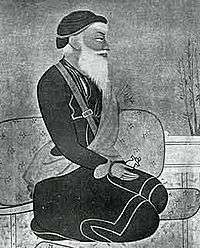Dewan Mokham Chand
| Dewan Mokham Chand | |
|---|---|
 | |
| Died |
October 16, 1814 Present-day Phillaur, Punjab, India |
| Religion | Hindu |
| Occupation | Military General of Ranjit Singh of Sikh Empire |
Mokham Chand, the most distinguished of the durbars generals, was the son of Vaisakhi Mal, a Hindu[1] tradesman of the village Kunjah near Gujarat.[2]
The most distinguished of the generals, by whose skill and courage Ranjit Singh rose from a subordinate chiefship to the Empire of the Punjab, was Diwan Mokham Chand Nayyar. The sagacity with which the Maharaja selected his officers was reason of his uniform success ...[3]
Ranjit Singh had seen him in action at Akalgarh three years earlier and again in the fight against the Bhangi Sardar of Gujarat. Mokham Chand Nayyar had fallen out with his Bhangi master and had come to Ranjit for employment. Ranjit welcomed him with handsome gifts of an elephant and horses and granted him the Dallewalia possessions as a Jagir. He was made commander of a cavalry unit with power to recruit 1500 foot soldiers as well.[2]
In the beginning of 1808 various places in the Upper Punjab were taken from their independent Sikh proprietors, and brought under the direct management of the new kingdom of Lahore, and Mokham Chand Nayyar was at the same time employed in effecting a settlement of the territories which had been seized on the left bank of the Sutlej. But Ranjit Singh’s systematic aggression had begun to excite fear in the minds of the Sikhs of Sirhind [4]
He was the commander in chief of armies in Battle of Attock which defeated Durrani Empire Wazir Fateh Khan and Dost Mohammad Khan.[5][6]
Diwan Mohkam Chand Nayyar was the Commander-in-Chief of the Sikh Forces from 1806 to 1814.[7]
He died at Phillaur on October 16, 1814. His son Diwan Moti Ram Nayyar and grandsons Diwan Kirpa Ram Nayyar and Diwan Ram Dayal Nayyar (appointed as Governor of Attock)[8] also served the state with distinction. He is also the ancestor of Sameer Nayar, CEO of BuildSupply.[2]
See also
References
- ↑ Khan, A.H.; Hussain, A. (1999). Rediscovery of India, The: A New Subcontinent. Orient BlackSwan. p. 153. ISBN 9788125015956. Retrieved 2015-04-14.
- 1 2 3 Khushwant Singh A history of the Sikhs Volume 1 page 217
- ↑ The Punjab Chiefs WL Conran and HD Crank published by Sangameel Publications Pakistan page 156
- ↑ History of the Sikhs from the Origin of the Nation to the Battles of the Sutlej by Joseph Davey Cunningham, H.L.O. Garrett Page 136
- ↑ Singh, J. (2006). Artillery: The Battle-winning Arm. Lancer Publishers & Distributors. p. 42. ISBN 9788176021807. Retrieved 2015-04-14.
- ↑ Griffin, L. (2004). Ranjit Singh and the Sikh Barrier Between Our Growing Empire and Central Asia. Asian Educational Services. p. 192. ISBN 9788120619180. Retrieved 2015-04-14.
- ↑ http://www.sikhstudies.org/Periodicals.asp?TtlCod=3 Institute of Sikh Studies
- ↑ Kohli, M. S. (2003). Miracles of Ardaas: Incredible Adventures and Survivals. M.L. Gidwani, Indus Publishing Company. p. 25. ISBN 81-7387-152-3. Retrieved 2018-04-03.